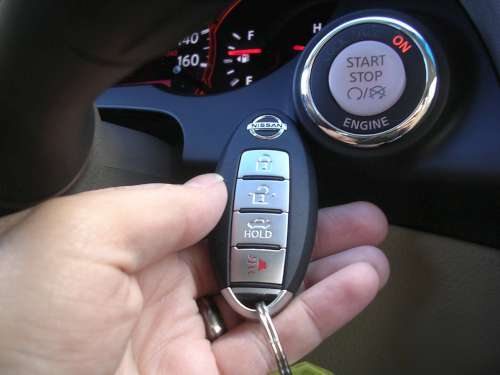January 18, 2016

If you own a car, truck or SUV with a keyless ignition, you are part of a growing number of new vehicle owners who can start their rides with a push of a button. The convenience of keyless ignition vehicles can be alluring yet potentially dangerous. For instance, a driver can forget to push the button on their key fob (pictured) after it’s no longer inside the vehicle. Forgetting this critical step while the vehicle is parked in an attached garage allows the engine to run while the garage fills with deadly carbon monoxide gas that can seep into the home. Can’t imagine making a similar mistake? It’s more common than you think, says Janette Fennell, founder and president of the safety group KidsAndCars.org. “We have documented at least 19 fatalities that are specifically attributed to keyless ignition vehicles since 2009 and 25 more close calls,” Fennell told NBC News. “As mores are sold, we are going to see these predictable and preventable injuries and deaths increase.” Sean Kane, president of the product hazards research group Safety Research & Strategies, points to “an inherent design defect” in keyless ignition vehicles that leads drivers to assume they’ve turned off the engine when they push the key fob to exit the vehicle. For this reason, keyless ignition critics advocate for installing a software update that turns the engine off automatically once the vehicle stops running. This auto shutoff feature would prevent vehicles from running while unattended and carbon monoxide fumes from being needlessly pumped into the atmosphere. A carbon monoxide analysis conducted by ABC News found that a typical keyless ignition vehicle—in this case a 2015 Chrysler 300—didn’t alert the driver that the engine was on after he used the key fob to exit the vehicle. The test conductors allowed the vehicle’s engine to run for a few hours, which was when they discovered that potentially lethal amounts of carbon monoxide built up inside the garage. Had it been an attached garage, said carbon monoxide specialist Tom Feiereisen, the levels of gas that leaked inside the house would’ve been lethal. The argument from automakers is that their keyless ignition vehicles typically include an audial and/or visual alert system that notifies drivers when the engine has been left running. Some vehicle engines shut off automatically, even if that feature isn’t as widespread as its proponents would like. Critics counter that the current standard alerts don’t do enough to warn drivers who aren’t in close proximity to their keyless ignition vehicles and that an automatic shutoff function would be more effective in reducing instances of carbon monoxide poisoning. This past summer, lawyers filed class action lawsuits against several automakers, including Ford, GM, Honda and Fiat Chrysler, to force them to heighten the safety protocols in their keyless ignition vehicles. This lawsuit indicted automakers for downplaying the carbon monoxide risks associated with keyless ignition vehicles. The lawyers representing plaintiffs in the suit want auto companies to install an auto shutoff in its keyless ignition vehicles, which they say could be installed at a negligible cost. The National Highway Traffic Safety Administration (NHTSA) identified keyless ignition vehicles a “clear safety problem” as far back as December 2011 and even proposed safety legislation that would reduce the incidence of running engines. However, they reject the auto shutoff proposal on the basis that there are scenarios in which drivers would need to keep their engines running while outside the vehicle, such as keeping the AC unit on in the sweltering heat. As of this writing, the NHTSA has made little progress on a law that would compel the auto industry to include an exterior alarm system in its keyless ignition vehicles. However, there are indications that the agency will reinvestigate the issue this upcoming February. Once the NHTSA announces the creation of a warning system for keyless ignition vehicles, we here at Auto Publishers will be sure to report on it. Image Credit: Eric Peters Autos
Hello {{User.FirstName}} {{User.LastName}}.
You are logged in with email {{User.Email}}.